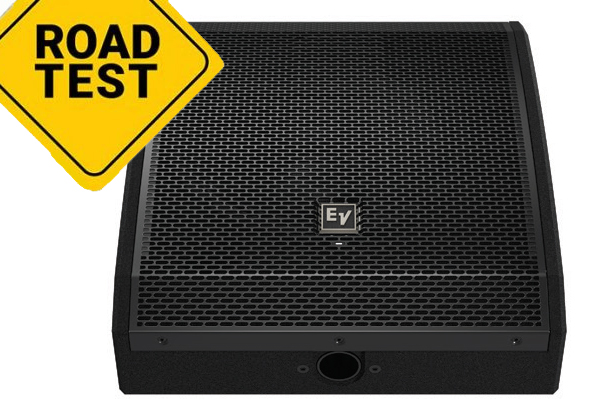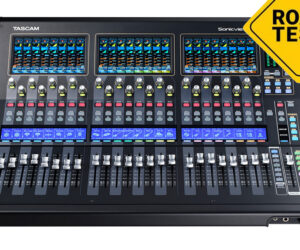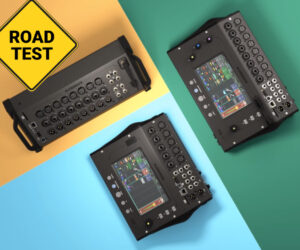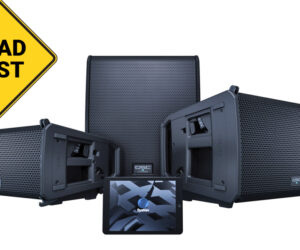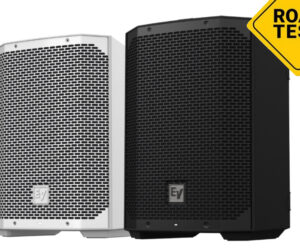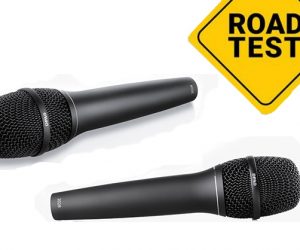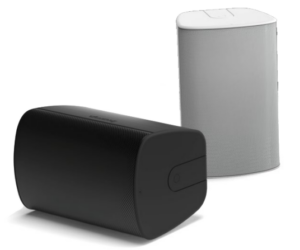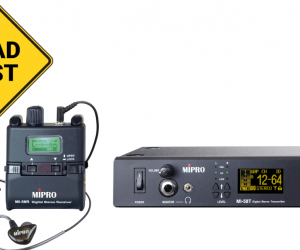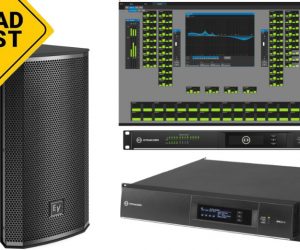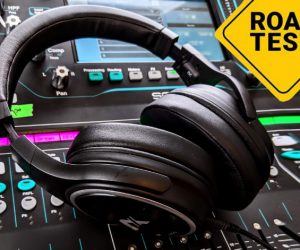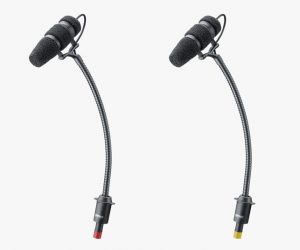The new Electro-Voice PXM-12MP is a powered co-axial stage monitor that was introduced at the NAMM show last January, and it marks the company’s debut in the powered monitor market. However, the PXM-12MP can actually serve as a multi-function loudspeaker incorporating a 12-inch woofer and 1.75-inch driver coaxial transducer that offers high output in a lightweight, small-footprint cabinet.
It’s powered by a class-D Dynacord-engineered amplifier stated to deliver 700 watts (500 for lows, 200 for highs), and also onboard is DSP and a 3-input mixer. The DSP includes individual presets for use as a floor monitor (x2), main loudspeaker and guitar cab.
Stated dispersion is 90 x 90 degrees, and when used in a stage wedge role, it offers a monitor angle of 55 degrees. Frequency response is listed as 64 Hz to 20 kHz (-3 dB) and 53 Hz to 20 kHz (-10 dB), with maximum SPL of 129 dB. The enclosure is made from 15 mm plywood and has a rugged black colored EV-Coat finish topped with a black powder-coated and fabric-backed steel grille. It measures 13.1 x 16.1 x 19 inches (H x W x D) and weighs 29.8 pounds. The cabinet is outfitted with a carrying handle per side, a pole socket mount on the front (more on this later), and a recessed connector and control panel on the side.
The control panel offers an LCD screen, master input navigation “push and turn” knob, 3-channel input level knobs, XLR/TRS input jacks for two channels, and a pair of RCA inputs for the third channel. Input 1 has an XLR “Thru” jack and there’s also a “Mix” XLR output. A power switch and IEC connector complete the control section.
The onboard DSP provides four voicings that include “MONITOR 1” (default setting optimized for floor monitoring duties). “MONITOR 2” (low-frequency boost for floor monitoring), “TRIPOD” (optimized for stand or subwoofer pole mounting) and “GUITARCAB” (optimized for use as a guitar or bass cab).

The user can also adjust the EQ with treble, mid frequency and bass controls, enable a high-pass filter if the loudspeaker is going to be used with a subwoofer, engage a narrow notch “feedback” filter, and employ phantom power to channels 1 or 2. In addition, users can select the routing to the MIX output and adjust a delay for the loudspeaker (up to 328.1 feet or 100 meters). Settings can be stored, recalled and locked, and there’s also the ability to reset the default settings.
Early Impressions
Unpacking the boxes in my shop (EV provided two units), the first thing I noticed was the light weight of the PXM-12MP. My old back prefers lighter gear now that I get the senior discount at my favorite restaurant, and at under 30 pounds, the cabinet is easy to handle. Next, I noticed the attractive look of the cabinet, with a pleasing curved shape sporting the heavy-duty powder-coated grille backed by fabric. Another feature that caught my eye was a cutout in the rear of the cabinet just next to the recessed control panel allowing users the option to route cables from the rear of the box as well as from the side. (Nice touch!)
I’m a big fan of coaxial monitors and they’re the only type we carry in my company’s inventory. They have a more compact footprint than traditional 2-way designs as well as providing a more uniform sound throughout their coverage pattern.

It was easy to navigate the menu to get to all the different settings. I plugged in different microphones and a tablet with a bunch of test tracks and gave the units a listen. Sonic quality was excellent, and they went way louder than I would ever need on the gigs my company typically works.
Scrolling through the different voicings I noticed that the MONITOR 2 setting supplied a nice low-end “bump” that would be perfect for use as a drum wedge without a sub or for performers who wanted some added low end on stage. Curious as to what the GUITARCAB setting sounded like, I grabbed a guitar and a pedal and plugged them into channel 2. The setting seems to emulate a guitar cabinet well, without a lot of the horn sound, just full-range cone speaker sound.
Placing one of the wedges on a tripod, I experimented with it as a mains cabinet. The TRIPOD tuning is really dialed in for this application. I also really like the stand socket placement; at first I thought the socket should have been positioned on the side opposite of the control panel, but after placement on the tripod, it dawned on me that if the socket was located on the side, the inputs and controls would be located on top, and in that position they would not be easily accessible. The DSP includes some settings for use with current EV subwoofers, and there are also adjustable crossover points so users can match up with any subwoofer.


